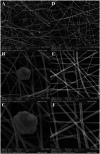Pullulan nanofibers containing the antimicrobial palindromic peptide LfcinB (21-25)Pal obtained via electrospinning
- PMID: 35514725
- PMCID: PMC9065569
- DOI: 10.1039/c9ra03643a
Pullulan nanofibers containing the antimicrobial palindromic peptide LfcinB (21-25)Pal obtained via electrospinning
Abstract
Electrospinning technology is useful for making ultrafine drug-eluting fibers for the clinical treatment of wounds. We show the incorporation of an antimicrobial LfcinB-derived peptide into Pullulan nanofibers. The palindromic peptide LfcinB (21-25)Pal: RWQWRWQWR was synthesized, purified, and characterized by means of the RP-HPLC and MALDI-TOF MS methods. The peptide's antibacterial activity against the E. coli ATCC 25922 strain was evaluated, and the peptide LfcinB (20-25)Pal exhibited significant antibacterial activity. Nanofibers were obtained by electrospinning a Pullulan or Pullulan-LfcinB (21-25)Pal solution. The obtained nanofibers were characterized via microscopy (AFM and SEM) and RP-HPLC chromatography. The peptide incorporation efficiency was 31%. The Pullulan-LfcinB (21-25)Pal nanofibers were soluble in water, and the peptide was liberated immediately. The Pullulan-LfcinB (21-25)Pal nanofibers exhibited the same antibacterial activity against E. coli strain as the free peptide LfcinB (21-25)Pal. The results suggest that Pullulan-LfcinB (21-25)Pal nanofibers could be considered for designing and developing antibacterial wound dressings.
This journal is © The Royal Society of Chemistry.
Conflict of interest statement
There are no conflicts to declare.
Figures






Similar articles
-
Selective cytotoxic effect against the MDA-MB-468 breast cancer cell line of the antibacterial palindromic peptide derived from bovine lactoferricin.RSC Adv. 2020 May 6;10(30):17593-17601. doi: 10.1039/d0ra02688c. eCollection 2020 May 5. RSC Adv. 2020. PMID: 35515633 Free PMC article.
-
Synergistic bactericide and antibiotic effects of dimeric, tetrameric, or palindromic peptides containing the RWQWR motif against Gram-positive and Gram-negative strains.RSC Adv. 2019 Mar 5;9(13):7239-7245. doi: 10.1039/c9ra00708c. eCollection 2019 Mar 1. RSC Adv. 2019. PMID: 35519960 Free PMC article.
-
Antibacterial nanofibers of pullulan/tetracycline-cyclodextrin inclusion complexes for Fast-Disintegrating oral drug delivery.J Colloid Interface Sci. 2022 Mar 15;610:321-333. doi: 10.1016/j.jcis.2021.12.013. Epub 2021 Dec 8. J Colloid Interface Sci. 2022. PMID: 34923270
-
Antibacterial biohybrid nanofibers for wound dressings.Acta Biomater. 2020 Apr 15;107:25-49. doi: 10.1016/j.actbio.2020.02.022. Epub 2020 Feb 19. Acta Biomater. 2020. PMID: 32084600 Review.
-
Pullulan-Based Hydrogels in Wound Healing and Skin Tissue Engineering Applications: A Review.Int J Mol Sci. 2023 Mar 4;24(5):4962. doi: 10.3390/ijms24054962. Int J Mol Sci. 2023. PMID: 36902394 Free PMC article. Review.
Cited by
-
Polysaccharide-Based Nanocarriers for Natural Antimicrobials: A Review.Polymers (Basel). 2025 Jun 24;17(13):1750. doi: 10.3390/polym17131750. Polymers (Basel). 2025. PMID: 40647761 Free PMC article. Review.
-
Selective cytotoxic effect against the MDA-MB-468 breast cancer cell line of the antibacterial palindromic peptide derived from bovine lactoferricin.RSC Adv. 2020 May 6;10(30):17593-17601. doi: 10.1039/d0ra02688c. eCollection 2020 May 5. RSC Adv. 2020. PMID: 35515633 Free PMC article.
-
Anti-Pseudomonas aeruginosa activity of natural antimicrobial peptides when used alone or in combination with antibiotics.Front Microbiol. 2023 Sep 5;14:1239540. doi: 10.3389/fmicb.2023.1239540. eCollection 2023. Front Microbiol. 2023. PMID: 37731929 Free PMC article. Review.
-
Delivery of streptomycin to the rat colon by use of electrospun nanofibers.Sci Rep. 2022 Dec 13;12(1):21503. doi: 10.1038/s41598-022-25769-z. Sci Rep. 2022. PMID: 36513721 Free PMC article.
-
Cyclotide-rich fractions containing nanofibers by electrospinning: preparation, characterization and examination of antimicrobial activity.Turk J Chem. 2022 Jul 19;46(5):1651-1660. doi: 10.55730/1300-0527.3468. eCollection 2022. Turk J Chem. 2022. PMID: 37529722 Free PMC article.
References
-
- Gomez J. P. Diaz G. A. Godoy J. A. Pediatria. 2001;36:16–21.
-
- Rosanova M. T. Stamboulian D. Led R. Arch. Argent. Pediatr. 2013;111:303–308. - PubMed
-
- Santalla A. López M. S. Ruiz M. D. Fernández J. Clin. Invest. Ginecol. Obstet. 2007;34:189–196.
-
- Píriz R. and Fuente M., Enfermería médico-quirúrgica, Difusión Avances de Enfermería, Madrid, 2nd edn, 2002, vol. 1, p. 483
LinkOut - more resources
Full Text Sources
Miscellaneous

